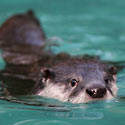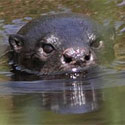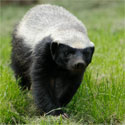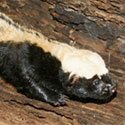|
Family: Mustelidae (otters, Honey badger,
weasel and polecat)
Life
>
Eukaryotes >
Opisthokonta >
Metazoa (animals) > Bilateria > Deuterostomia >
Chordata > Craniata > Vertebrata (vertebrates) >
Gnathostomata (jawed vertebrates) > Teleostomi (teleost
fish) > Osteichthyes (bony fish) > Class:
Sarcopterygii (lobe-finned fish) > Stegocephalia
(terrestrial vertebrates) > Reptiliomorpha > Amniota >
Synapsida (mammal-like reptiles) > Therapsida > Theriodontia
> Cynodontia > Mammalia (mammals)
> Placentalia (placental mammals) > Laurasiatheria
> Ferungulata > Ferae > Carnivora
Species indigenous to southern Africa
|
Subfamily: Lutrinae |
|
|
|
Aonyx capensis (African clawless otter)
The otter’s body is elongated, sinuous and agile designed
for active swimming. It depends on its acute sense of touch, when searching for
prey such as crabs under stones and in crevices. Although it normally hunts by
sight, the well developed sense of touch allows it to find prey in water with
poor visibility. Otters are active during the early morning and the late
afternoon, although they may hunt at anytime. Otters occur singly, in pairs or
small family groups.
|
 |
|
|
Lutra maculicollis (Spotted-necked otter)
|
 |
|
Subfamily: Mellivorinae |
|
|
|
Mellivora capensis (Honey badger)
|
 |
|
Subfamily: Mustelinae |
|
|
|
Poecilogale albinucha (African striped weasel)
|
 |
|
|
Ictonyx striatus (Striped polecat)
|
|
|
